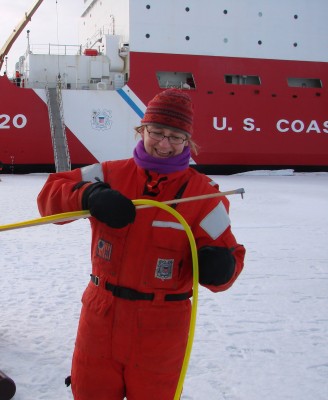 Julie Granger, Assistant Professor
Julie Granger, Assistant Professor
I studied biology as an undergraduate at McGill University, where I graduated with Honours in Biology, with a focus on marine ecology. I stayed at McGill to pursued a Masters’ degree, during which I conducted research on iron-siderophore production and acquisition by heterotrophic marine bacteria in the laboratory of Dr. Neil Price. I then began work at Princeton University as a research technician in the laboratory of Dr. Bess Ward, doing research on metal requirements of denitrifying bacteria. I returned to Canada for to pursue my doctorate, in the laboratory of Dr. Philippe Tortell at the University of British Columbia. There, I engaged in a collaboration with Dr. Daniel Sigman at Princeton University, to investigate patterns in nitrate N and O isotope fractionation during nitrate consumption by marine plankton. I returned to Princeton to conduct research as a post-doctoral fellow in Sigman’s lab, where I investigate nitrogen biogoechemical cycling on the eastern Bering Sea shelf. I became an assistant professor at the University of Connecticut in the fall of 2011, where I have been since.
Current Members
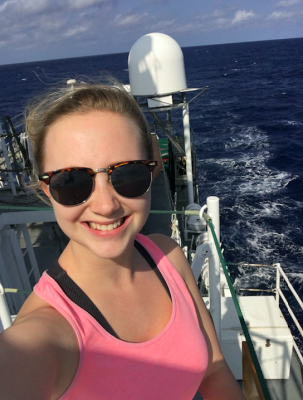
Danielle Boshers, M.S. student (2017), Research Technician
Danielle obtained an honors B.S. in Earth and Environmental Sciences at the Univesity of Michigan, at which time she completed an Honors Thesis in Dr. Gregory Dick’s lab, conducting research on a novel Mn oxidizing bacteria. For her master’s thesis work here at UConn, Danielle is studying how the oxygen isotope composition of ambient water influences the 18O/16O of nitrate produced by nitrification, in cultures of model organisms and in freshwater environments. During her time at UConn, Danielle has conducted field work at an experimental aquifer in Cape Cod, gone on an oceanographic cruise on the RV Endeavor, and presented her research at AGU in San Francisco and Goldschmidt in Paris, France.
 Michael Mathuri, Ph.D. candidate
Michael Mathuri, Ph.D. candidate
Michael is a first year student here at UConn and a new member of my lab. He obtained an undergraduate degree in Biochemistry at Kenyatta University in Kenya and later joined M.S. Program in Geological Sciences at the University of Texas at El Paso, where he worked in Dr. Benjamin Brunner’s lab. For his master’s thesis, he used 34S and 18O isotopes to investigate sulfur cycling in marine sediments. In my lab, Michael will use stable nitrogen isotopes to study the process of ammonium assimilation in cultures of marine phytoplankton.
Veronica Rollinson, M.S. student
Veronica graduated from UConn Avery Point in May 2012 with a B.S. in Marine Science. Veronica has worked in the Marine Science Department since 2011 under Dr. Craig Tobias as a research specialist where she has assisted graduate students in field research including sampling of Niantic River Estuary, Long Island Sound, New River Estuary North Carolina, and Cape Cod Aquafer. She has lead analysis of stable isotopic composition of algal samples from St. John U.S. Virgin Islands. For her master’s project she will be studying nitrogen cycling through stable isotopic tracers for the Pawcatuck River and Little Narragansett Bay in order understand the relationship to invasive macroalgeal populations in the river.
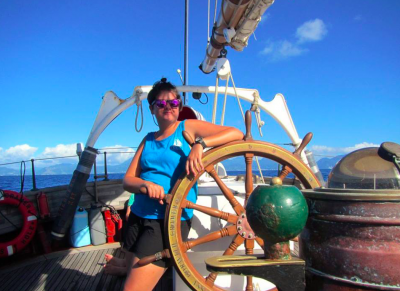
Holly Westbrook, Research Technician
Holly graduated from UConn Avery Point with a B.S. in Marine Science with a minor in Chemistry in May of 2017. During her time as an undergrad she participated in a SEA Semester, which was a transatlantic crossing focusing on climate change and the global carbon cycle. She began working in the Granger lab in May 2017. Previous duties involved maintenance of in situ equipment in Wequetequock Cove and sampling in the Pawcatuck River over the summer of 2017. She is currently working on an experiment regarding the δ18O to δ15N relationship during nitrate consumption in different aquatic environments, which will be presented on a poster at Ocean Sciences 2018.
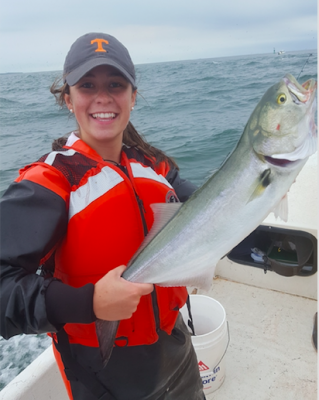
Reide Jacksin, Undergraduate Research Technician
Reide is a second-year undergraduate student at UConn Avery Point pursuing a degree in chemistry. With that degree, she hopes to teach high school chemistry. Her main duties in the lab are sample preparation and lab maintenance.
Lindsey Potts, Research Technician
Staff
Gregory Cane, Technical Assistant
Past Members
 Lija Treibergs, M.S. student (2015)
Lija Treibergs, M.S. student (2015)
Lija obtained an undergraduate degree in Geosciences at Princeton University, at which time she completed an Honors Thesis in the laboratory of Danny Sigman, conducting research on N assimilation by surface plankton at the Bermuda Atlantic Time Series (Treibergs et al. 2014). For her master’s research at UConn, Lija investigated the enzymatic isotope effects of assimilatory and dissimilatory reductases, availed comercially or isolated from model organisms. She uncovered characteristic patterns in nitrate N and O isotope fractionation shared among reductase functional groups, and further demonstrated that the amplitude of the enzymatic isotope effect varies in response to substrate and reductant concentrations (Treibergs 2015). Since finishing her thesis, Lija has been employed as a technical research staff at the University of Michigan.
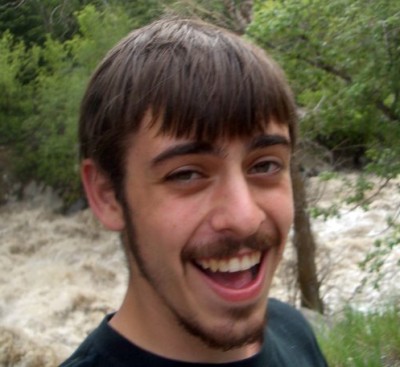 Richard Dabundo, M.S. student (2014), Research Technician
Richard Dabundo, M.S. student (2014), Research Technician
Rich studied Geosciences at Penn State University and became interested in Geobiology. At UConn, Rich began studying N2-fixation by heterotrophic bacteria, which led him to discover that some commercial 15N2 stocks, typically used to measure N2-fixation rates, are highly contaminated with 15N-ammonium and nitrate (Dabundo et al. 2014). Following some initial despair, Rich percevered and began investingating environmental controls on the denitrification isotope effect in cultures of model organisms. He demonstrated that the isotope effect is sensitive to modulations in active cellular nitrate transport, which, in turn, appears to responds to changes in the redox state of the bacterial membrane. The redox state of the membrane can be influenced by carbon substrates, and by trace oxygenation in the medium (Dabundo 2014). Following his thesis, Rich worked as a research technician in the laboratory, then recently set off to travel the world.
Visiting Students and Scholars
 Nadine Lehman, visiting student, Ph.D. candidate (Dalhousie University)
Nadine Lehman, visiting student, Ph.D. candidate (Dalhousie University)
Nadine is a doctoral candidate at Dalhousie University in Markus Kienast’s laboratory. Nadine is measuring nitrate N and O isotope ratios in the Gra laboratory as part of the Canadian Arctic GEOTRACES program, a research project on marine biogeochemical cycles of trace elements and their isotopes. The focus of her work is the cycling of nitrogen and the geochemical modification of waters as they flow from the Pacific to the Labrador Sea. Nadine is interested in using the N and O isotopic composition of nitrate as a geochemical tracer to describe both nutrient cycling and water mass distributions in the Ocean.
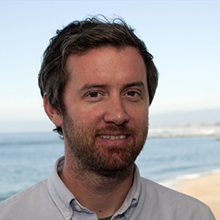 Jason Smith, Visiting post-doctoral scholar
Jason Smith, Visiting post-doctoral scholar
Jason is a rogue scientist, interested in N cycling in upwelling systems. Jason has visited the lab at UConn numerous times to make measurements of the 15N/14N of N pools in the California Upwelling, including exacting measurements of the 15N/14N of ammonium, which exists at very low concentrations at the surface ocean. His measurements are providing novel insights into seasonal N cycling, revealing an important role of nitrification in regenerating nitrate at the sea surface.